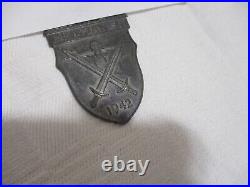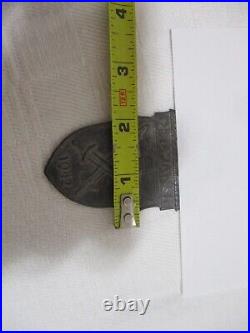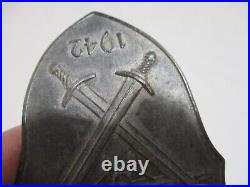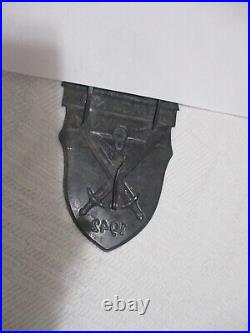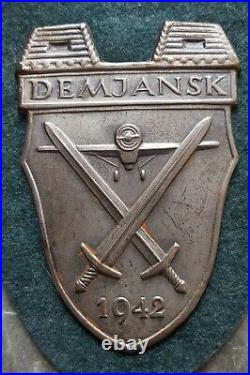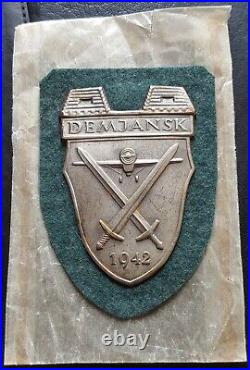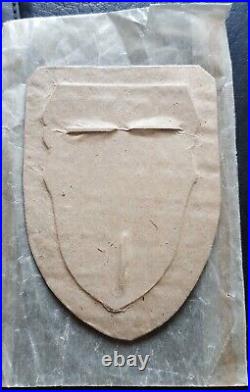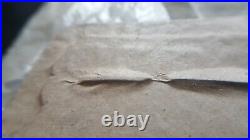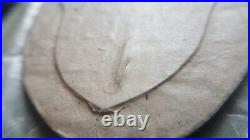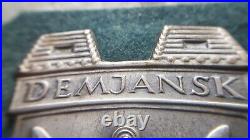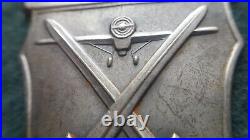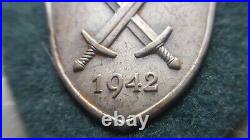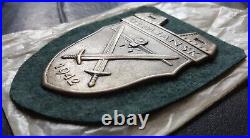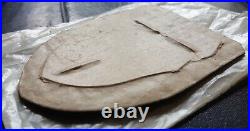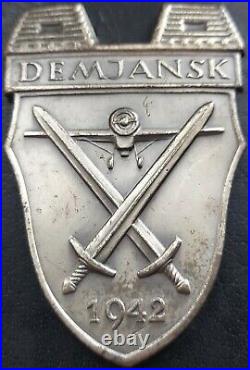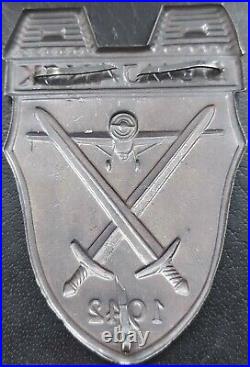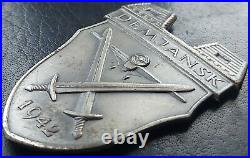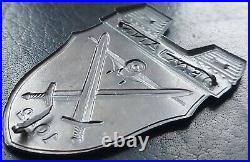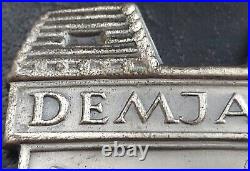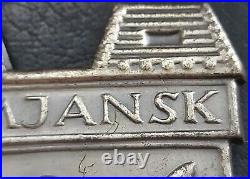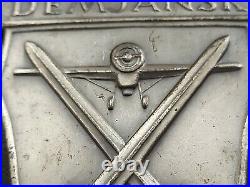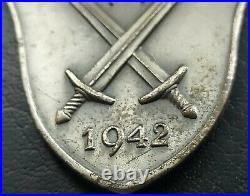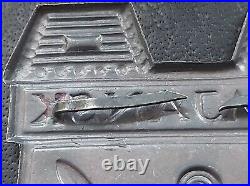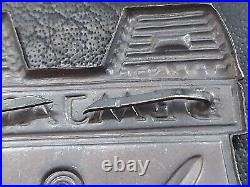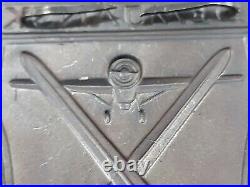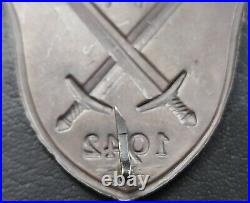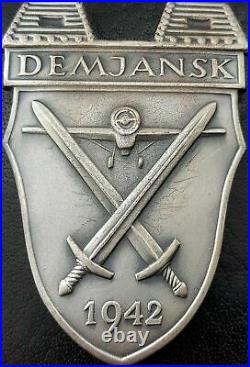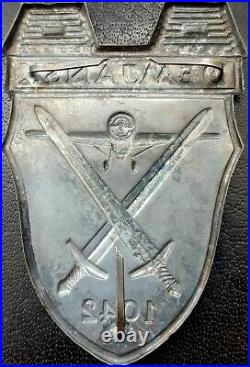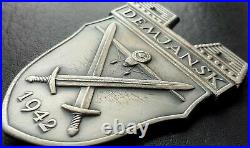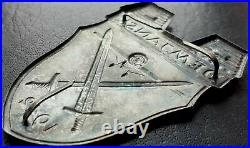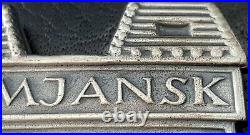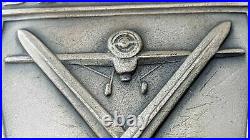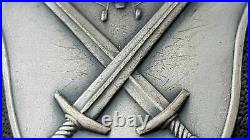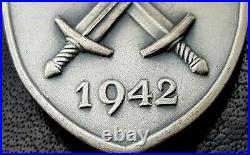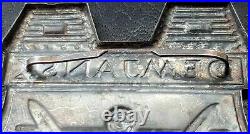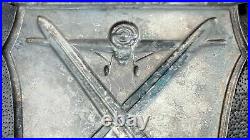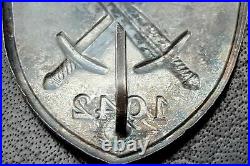Original German post WW2 – 1957 Pattern Demjansk Shield, IN VERY GOOD CONDITION, THREE INTACT PRONGS & PAPER BACKING ON FABRIC WITH AWARD ENVELOPE, GENUINE STEINHAUER UND LUECK (ST&L) MADE EXAMPLE, A VERY GOOD DETAILED PIECE – NOT EASY TO FIND. FEW FACTS ABOUT 1957 PATTERN AWARDS. In 1957 the West German government authorised replacement Iron Crosses with an Oak Leaf Cluster in place of the swastika, similar to the Iron Crosses of 1813, 1870, and 1914, which could be worn by World War II Iron Cross recipients. The 1957 law also authorised de-Nazified versions of most other World War II-era decorations (except those specifically associated with Nazi Party organizations, such as SS Long Service medals, or with the expansion of the German Reich, such as the medals for the annexation of Austria, the Sudetenland, and the Memel region). The main government contract to manufacture and supply these new de-nazified WW2 1957 official decorations went to the world famous German firm Steinhauer & Lueck, Luedenscheid Germany. Knights Crosses, Iron Crosses, Wound Badges, Tank Assault Badges etc were re-designed by Steinhauer & Lück – often with the oak-leaf spray replacing the swastika, with S&L having the sole patent rights to all WW2 1957 German decorations. S&L did not have the whole monopoly on medal making, other famous firms such as Deschler & Sohn, BH Maher and Juncker also manufactured these new German decorations. Lüdenscheid is situated between the cities Dortmund and Bonn. It was here that one of the youngest medal firms was founded in 1889 by August Steinhauer and Gustav Adolf Lück. The first production began in a cellar, the customer base continued to increase. A property was bought at 51 Hochstrasse which is still home for this famous company today. During WW2 Steinhauer & Lück produced medals and badges, like the famous Knights Cross and many other types of medals and badges. In 1957 this company was awarded the contract to produce all the newly re-designed legal WW2 1957 de-nazified decorations, plus the contract to manufacture all of Germany’s official decorations including Germany’s highest order the Bundesverdienstkreuz. Only a very limited number of original WW2 1957 medals are still produced, mainly Iron Crosses, German Cross Gold & Silver & Wound Badges and are considered 100% genuine by the German Government. HISTORY OF THE AWARD. Demjansk Shield – On February 8th 1942, the Russians encircled the 2nd Army Corp in the small town of Demjansk, located in the northern section of the Russian front about 100 miles north-east of Cholm. Trapped in the pocket were the 12th, 30th, 32nd, 223rd and 290th Heer Infantry Divisions, as well as the 3rd SS “Totenkopf” Division. There were also RAD, Police, Todt organization, and other auxiliary units who were trapped and assisted in the battle. Their commander was General der Infanterie Graf Brockdordd-Ahlefeldt. Ordered to resist, the garrison was extensively and appropriately supplied by the Luftwaffe. During their besiegement the group offered the Russians stiff and determined resistance, tying up three Soviet Armies (composed of 18 Infantry Divisions and three brigades) for the length of 14 months. The battle group was able to break out of the siege on the 21st of April, but the battle had taken a toll. Even thought they were no longer trapped, fighting in the area continued until October of 1942. For his excellence in command in the particularly fierce fighting of his elite unit, Totenkopf commander SS Obergruppenfuhrer und General der Waffen SS Theodor Eike was awarded the Oak Leaves to the Knights Cross (88th) on May 20th, 1942. Owever, their heroic struggle had denied the Soviet High Command of numerous units at a critical moment, units that would have otherwise been used elsewhere in the Eastern front. This item is in the category “Collectables\Militaria\World War II (1939-1945)\Medals/ Ribbons”. The seller is “a..anderson” and is located in this country: GB. This item can be shipped worldwide.
- Country/Region of Manufacture: Germany
- Country/ Organization: Germany
- Issued/ Not-Issued: Issued
- Type: Medals & Ribbons
- Conflict: World War II (1939-1945)
- Service: Army
- Era: 1914-1945
